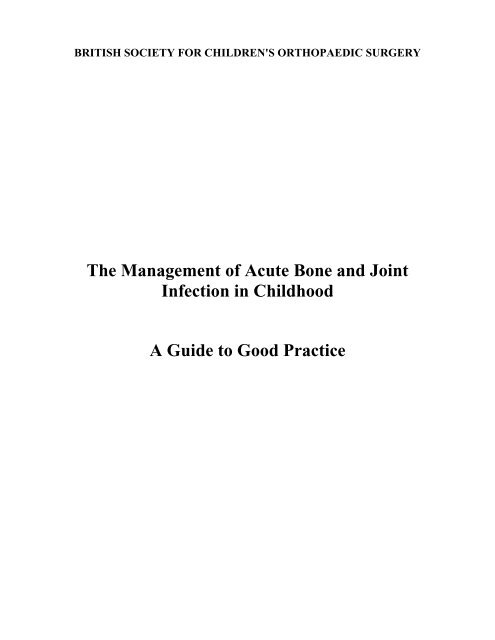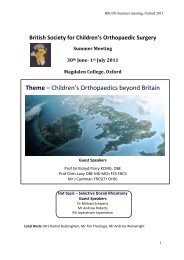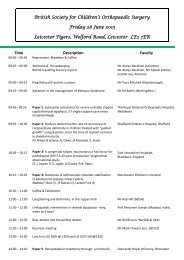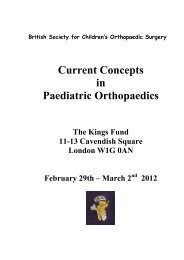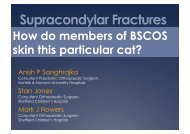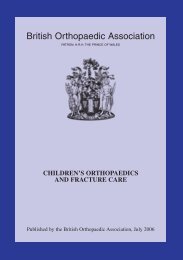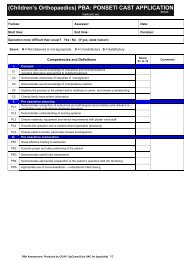The Management of Acute Bone and Joint Infection - Bscos.com
The Management of Acute Bone and Joint Infection - Bscos.com
The Management of Acute Bone and Joint Infection - Bscos.com
You also want an ePaper? Increase the reach of your titles
YUMPU automatically turns print PDFs into web optimized ePapers that Google loves.
BRITISH SOCIETY FOR CHILDREN'S ORTHOPAEDIC SURGERY<br />
<strong>The</strong> <strong>Management</strong> <strong>of</strong> <strong>Acute</strong> <strong>Bone</strong> <strong>and</strong> <strong>Joint</strong><br />
<strong>Infection</strong> in Childhood<br />
A Guide to Good Practice
1. Introduction<br />
1.1 This document sets out a statement <strong>of</strong> good practice in the management <strong>of</strong> bone <strong>and</strong><br />
joint infection in children that has been approved by the Council <strong>of</strong> the British<br />
Orthopaedic Association <strong>and</strong> by the British Society for Children’s Orthopaedic<br />
Surgery.<br />
1.2 <strong>The</strong> document aims to assist doctors in making decisions, under specific clinical<br />
circumstances, on the basis <strong>of</strong> a review <strong>of</strong> the best available evidence <strong>of</strong> effective<br />
clinical practice. <strong>The</strong> re<strong>com</strong>mendations given should, in most cases, give<br />
predictable results. Appropriate decisions should lead to an improvement in care.<br />
1.3 Two conditions will be considered – acute haematogenous osteomyelitis <strong>and</strong> acute<br />
septic arthritis.<br />
1.4 <strong>The</strong> best results are achieved in children when the diagnosis is made early <strong>and</strong><br />
appropriate therapy <strong>com</strong>menced.<br />
1.5 <strong>The</strong>re are wide variations in the management <strong>of</strong> these conditions. Whilst local<br />
variation may be justified, particularly with respect to the choice <strong>of</strong> antibiotics, not<br />
all can be. This document aims to assess the weight <strong>of</strong> evidence for various<br />
therapies <strong>and</strong>, on that basis, give re<strong>com</strong>mendations for the treatment <strong>of</strong> the<br />
individual child.<br />
September 2004<br />
2
2. Definitions<br />
2.1 <strong>Acute</strong> haematogenous osteomyelitis has been defined as ‘an inflammation <strong>of</strong> bone<br />
caused by pyogenic organisms settling from the blood stream, their presence being<br />
proven by culture or their effect on bone, this being demonstrated<br />
radiographically’ 2 . <strong>The</strong> duration <strong>of</strong> symptoms is less than two weeks 7 .<br />
2.2 <strong>Acute</strong> septic arthritis is the inflammation <strong>of</strong> a joint caused by pus-forming<br />
organisms.<br />
3
3. <strong>The</strong> Scope <strong>of</strong> the Problem<br />
3.1 Prior to the introduction <strong>of</strong> antibiotics, the mortality <strong>and</strong> morbidity was high. From<br />
1936-1940 the mortality in one series was 36% 19 . In children under the age <strong>of</strong> 6<br />
months death was even more <strong>com</strong>mon 8 . Since the advent <strong>of</strong> chemotherapy the<br />
emphasis has progressively shifted from survival to limb preservation <strong>and</strong> finally to<br />
the maintenance <strong>of</strong> normal function <strong>and</strong> growth <strong>of</strong> the affected limb or joint.<br />
3.2 <strong>The</strong> condition is be<strong>com</strong>ing less <strong>com</strong>mon. A population-based study has shown a<br />
steady fall over a 28 year period 3 . It is now relatively rare, with an annual incidence<br />
<strong>of</strong> 2.9/100,000 child population. Septic arthritis is twice as <strong>com</strong>mon as osteomyelitis<br />
in infants <strong>and</strong> early childhood. In later childhood the incidence is the same.<br />
3.3 Whilst the fall in incidence is to be wel<strong>com</strong>ed, it does make the condition less<br />
familiar <strong>and</strong>, as a consequence, it may <strong>com</strong>e less readily to mind as a possibility in a<br />
difference diagnosis. It is widely recognised that the earlier the diagnosis is made<br />
<strong>and</strong> effective treatment <strong>com</strong>menced, the more likely is an excellent out<strong>com</strong>e. Delay<br />
can result in the development <strong>of</strong> <strong>com</strong>plications <strong>and</strong> produce permanent impairment.<br />
4
4. Diagnosis<br />
4.1 Early diagnosis <strong>and</strong> treatment hold the key to a good result. So long as the condition<br />
is considered as a possibility it is unlikely to be missed. Both bone <strong>and</strong> joint<br />
infections are based on clinical suspicion confirmed by physical findings.<br />
4.2 An unwell, pyrexial child with localised tenderness <strong>and</strong> loss <strong>of</strong> function has bone or<br />
joint infection until proved otherwise <strong>and</strong> should be treated as such. Typically a<br />
young child will refuse to use a limb <strong>and</strong> an older one will <strong>com</strong>plain <strong>of</strong> pain. Young<br />
children may present with little other than irritability 22 . Neonates may produce a<br />
more <strong>com</strong>plex clinical picture. <strong>The</strong>ir immune system is less well developed <strong>and</strong> the<br />
infecting organisms may be less virulent than those found in older children. <strong>The</strong>y<br />
may not be pyrexial. <strong>The</strong> infection, particularly in the premature infant, may be<br />
multifocal.<br />
5
5. Laboratory Investigations<br />
5.1 <strong>The</strong>se are not to be relied upon, particularly in the neonate. It is a clinical diagnosis.<br />
That said, the C-reactive protein (CRP) is a more accurate parameter, both <strong>of</strong> activity<br />
<strong>and</strong> response to treatment, than the eryrthrocyte sedimentation rate (ESR) 18 . It is<br />
raised within 6 hours <strong>of</strong> the onset <strong>of</strong> infection <strong>com</strong>pared to 48-72 hours for the<br />
ESR 16 . <strong>The</strong> ESR takes 2-4 weeks to return to normal after the elimination <strong>of</strong> the<br />
infection whereas the CRP falls much more quickly 13 .<br />
5.2 <strong>The</strong> white cell count is usually, but not always, raised.<br />
5.3 Blood cultures are positive in about 50% <strong>of</strong> children with acute septic arthritis or<br />
acute haematogenous osteomyelitis 20 . Bacteria are isolated in 80% <strong>of</strong> arthrotomies<br />
<strong>and</strong> 70% <strong>of</strong> joint aspirates. With either <strong>of</strong> these procedures an immediate Gram stain<br />
should be done.<br />
5.4 Saline instillation may facilitate joint aspiration but only rarely will it facilitate<br />
bacterial culture. It is even less useful in osteomyelitis.<br />
5.5 Synovial fluid analysis normally yields a white cell count <strong>of</strong> over 50,000, with more<br />
than 80% being polymorphs.<br />
6
6. Ultrasonography <strong>and</strong> Radiology<br />
6.1 In the acute stage there are no changes on the plain films although s<strong>of</strong>t tissue<br />
swelling may be apparent. Skeletal changes are unlikely to be seen before 5-7 days.<br />
6.2 Ultrasound examination will demonstrate subperiosteal swelling due to oedema in<br />
the early stages <strong>and</strong>, later, abscess formation. It is particularly useful in<br />
demonstrating the presence <strong>of</strong> an effusion in the hip joint. For a neonate or a young<br />
infant with potentially many joints involved, ultrasound scanning facilitates the<br />
detection <strong>of</strong> an effusion easily <strong>and</strong> readily at most joints <strong>and</strong> may be repeated without<br />
difficulty.<br />
6.3 Although bone scans may be positive as early as 24-48 hours, they are not particularly<br />
useful in the acute condition. Aspiration <strong>of</strong> a joint will not affect the results <strong>of</strong> a later<br />
bone scan. <strong>Bone</strong> scanning can prove valuable in an infant where multifocal<br />
involvement is suspected or where the infection may be in an unusual anatomical site<br />
such as the pelvis. MRI scanning has little part to play in routine assessment.<br />
7
7. Organisms<br />
7.1 Close liaison with the bacteriology <strong>and</strong> infectious diseases departments is essential<br />
to ascertain the local likelihood <strong>of</strong> infection by infecting organisms <strong>and</strong> their<br />
probable sensitivities.<br />
7.2. In the neonate, staphylococci, streptococci <strong>and</strong> gram negative bacilli predominate<br />
whereas, in older children, staphylococci <strong>and</strong> streptococci are most <strong>of</strong>ten implicated.<br />
7.3 Previously, Haemophilus had to be considered, particularly in younger<br />
children. It can now be discounted in a child who has been vaccinated against it 9 .<br />
8
8. Treatment<br />
8.1 <strong>The</strong> principles <strong>of</strong> management are to identify the organism, select the correct<br />
antibiotic, deliver it effectively <strong>and</strong> minimise s<strong>of</strong>t tissue destruction. This means rest<br />
for the patient <strong>and</strong> immobilisation <strong>of</strong> the affected part. This is achieved by placing<br />
the limb or joint in a plaster back slab in its position <strong>of</strong> function <strong>and</strong> applying<br />
dressings in such a way that the part can be examined on a daily basis. <strong>The</strong> infected<br />
limb or joint may require de<strong>com</strong>pression or debridement <strong>and</strong> antibiotics should be<br />
administered.<br />
8.2 <strong>Acute</strong> Haematogenous Osteomyelitis. Previously, surgery in the form <strong>of</strong> exploration<br />
<strong>of</strong> the affected part <strong>and</strong> cortical drilling was <strong>com</strong>monly performed. Cole et al. 4<br />
considered that operation was indicated only with evidence <strong>of</strong> abscess formation.<br />
S<strong>of</strong>t tissue drainage without fenestration was then re<strong>com</strong>mended. Gillespie <strong>and</strong><br />
Mayo 6 in a retrospective study, <strong>and</strong> Lamont et al. 12 , in a prospective study, found a<br />
higher failure rate when surgery had been undertaken. Lamont et al. 12 found no<br />
advantage in out<strong>com</strong>e in surgically versus conservatively treated patients.<br />
8.3 Conclusion: Routine exploration <strong>of</strong> an osteomyelitic focus is not re<strong>com</strong>mended.<br />
Failure to respond to antibiotics or evidence <strong>of</strong> local abscess formation should be the<br />
main indications. If bony changes are present <strong>and</strong> surgery is undertaken then a<br />
specimen should always be sent for histology to exclude a Ewing’s sar<strong>com</strong>a.<br />
8.4 Should the joint be aspirated or opened? <strong>The</strong> rationale <strong>of</strong> both is to remove, as far as<br />
is possible, the products <strong>of</strong> inflammation. Even in the absence <strong>of</strong> viable microorganisms<br />
these can cause destruction <strong>of</strong> articular cartilage. In the infant hip, all are<br />
agreed that surgical drainage, as a matter <strong>of</strong> urgency, should be undertaken 16, 21 .<br />
More superficial joints can be managed by aspiration, repeated if necessary 10, 18 .<br />
<strong>The</strong>re is no place for intra-articular infusion <strong>of</strong> antibiotics as these can cause damage<br />
to the joint surfaces.<br />
8.5 Conclusion: A septic arthritis <strong>of</strong> the hip in an infant should be drained at open<br />
operation. Above the age <strong>of</strong> one there is no evidence that exploration leads to better<br />
results than aspiration.. Aspiration, which may need to be repeated, can be sufficient<br />
in other joints. Open operation remains the treatment <strong>of</strong> choice when urgent<br />
de<strong>com</strong>pression is required or other drainage methods have failed 22 .<br />
9
9. Choice <strong>of</strong> Antibiotic<br />
9.1 Before starting antibiotics, samples for bacteriological examination should have<br />
been taken from all possible sites.<br />
9.2 All chemotherapeutic agents should be bactericidal. <strong>The</strong> choice should initially be<br />
made on a best guess basis 2 , pending bacteriological confirmation.<br />
9.3 In general, under the age <strong>of</strong> one year, the most probable organisms are<br />
staphylococci, streptococci or gram negative bacilli. Flucloxacillin plus gentamicin<br />
would be suitable antibiotics, dependent on local experience. Above that age<br />
staphylococci predominate, with a minority <strong>of</strong> infections caused by streptococci.<br />
<strong>The</strong>n, appropriate initial antibiotics might be flucloxacillin with the addition <strong>of</strong><br />
penicillin or a cephalosporin. Where a child is not immunized against haemophilus<br />
Cefotaxime should be included in the antibiotic regime. Once identification <strong>of</strong> the<br />
organism has been made, then appropriate adjustments to the regime may be<br />
required.<br />
9.4 <strong>The</strong>se are general re<strong>com</strong>mendations <strong>and</strong> local guidelines should be drawn up in<br />
consultation with the bacteriological department.<br />
9.5 Conclusion.<br />
<strong>The</strong> basic drug is flucloxacillin with the addition <strong>of</strong> gentamicin in the under one year<br />
age group <strong>and</strong> penicillin or a cephalosporin in older children. <strong>The</strong>se may be<br />
changed once the infecting organism has been identified. Clindamycin can be used<br />
where there is penicillin allergy.<br />
10
10. Route <strong>of</strong> Administration<br />
10.1 Antibiotics are initially best delivered intravenously. This ensures reliable <strong>and</strong><br />
safe absorption in a sick child.<br />
10.2 <strong>The</strong> duration <strong>of</strong> parenteral antibiotics is debatable. Traditionally the intravenous<br />
route was used for between 2 <strong>and</strong> 4 weeks 11 . Evidence for such prolonged<br />
administration is lacking. In a r<strong>and</strong>omised trial 12 the results <strong>of</strong> intravenous<br />
administration for 3 days <strong>and</strong> 4 weeks were <strong>com</strong>pared. No difference was found.<br />
<strong>The</strong> conclusion was that, presuming adequate absorption, a short intravenous<br />
course, followed by oral administration was as effective as prolonged parenteral<br />
therapy. Cole, Dalziel <strong>and</strong> Leith 5 in a retrospective study found that an early<br />
change to oral therapy did not increase the risk <strong>of</strong> recurrence. Vaughan et al. 17<br />
reached a similar conclusion.<br />
In each case the change <strong>of</strong> route <strong>of</strong> administration was made when the child was<br />
clinically improving, apyrexial <strong>and</strong> the CRP was falling.<br />
10.3 Conclusion.<br />
Short-term intravenous antibiotics, both in osteomyelitis <strong>and</strong> septic arthritis, are as<br />
effective as those delivered for a long period 11 .<br />
11
11. Duration <strong>of</strong> Treatment<br />
11.1 <strong>The</strong>re is a lack <strong>of</strong> evidence upon which to base any re<strong>com</strong>mendations.<br />
Empirically 3 – 6 weeks has been the usual regime but there is little hard data<br />
upon which to base this opinion.<br />
12
12. Conclusion<br />
12.1 Most children with bone <strong>and</strong> joint infection make an excellent recovery. Residual<br />
damage is usually the consequence <strong>of</strong> late diagnosis or inadequate treatment.<br />
13
References<br />
1. Blockey N, McAllister T (1972). Antibiotics in <strong>Acute</strong> Osteomyelitis in Children.<br />
J <strong>Bone</strong> <strong>Joint</strong> Surg. 54B, 299-309<br />
2. Blockey N, Watson JT (1970). <strong>Acute</strong> Osteomyelitis in Children.<br />
J <strong>Bone</strong> <strong>Joint</strong> Surg. 52B, 77-<br />
3. Blyth M, Craigen M, Bennet GC (2001). <strong>The</strong> Changing Epidemiology <strong>of</strong> <strong>Acute</strong><br />
<strong>and</strong> Subacute Haematogenous Osteomyelitis in Children.<br />
J <strong>Bone</strong> <strong>Joint</strong> Surg. 83B, 99-102<br />
4. Cole WG, Dalziel RE, Leith S. (1982). <strong>The</strong> Treatment <strong>of</strong> Osteomyelitis in Children.<br />
J <strong>Bone</strong> <strong>Joint</strong> Surg. 64B, 218-223<br />
5. Howard DA, Viskontas D, Sabbagh C (1999). Reduction in Osteomyelitis <strong>and</strong> Septic<br />
Arthritis Related to Haemophilus Influenza Type B Vaccine.<br />
J Ped Orth 19, 705-709<br />
6. Gillespie WJ, Mayo KM (1981). <strong>The</strong> <strong>Management</strong> <strong>of</strong> <strong>Acute</strong> Haematogenous<br />
Osteomyelitis in the Antibiotic Era.<br />
J <strong>Bone</strong> <strong>Joint</strong> Surg. 63B, 126-131<br />
7. Green W. (1997). In Staheli L “Pediatric Orthopaedic Secrets” p332-343<br />
Hanley <strong>and</strong> Belfus, Philadelphia<br />
8. Green WT, Shannon JG (1936). Osteomyelitis in Infants: a Disease Different from<br />
Osteomyelitis in Older Children.<br />
Archives <strong>of</strong> Surgery 32, 462-493<br />
9. Kim HK, Alman B, Cole WG (2000). A Shortened Course <strong>of</strong> Parenteral Antibiotics<br />
<strong>The</strong>rapy in the <strong>Management</strong> <strong>of</strong> <strong>Acute</strong> Septic Arthritis <strong>of</strong> the Hip.<br />
J Ped. Orthop. 20, 44-47.<br />
10. Kocher M, M<strong>and</strong>iga R, Murphy R, Goldmann D, Harper M, Sundel R, Ecklund C,<br />
Kasser J (2003). A Clinical Practice Guideline for Treatment <strong>of</strong> Septic Arthritis in<br />
Children.<br />
J <strong>Bone</strong> <strong>Joint</strong> Surg. 85A, 994-999<br />
11.Kolyvas E, Ahronheim G, Marks MI, Gledhill, R, Owen H, Rosenthall L (1980).<br />
Oral Antibiotic <strong>The</strong>rapy <strong>of</strong> Skeletal <strong>Infection</strong>s in Children.<br />
Pediatrics 65, 867-871<br />
14
12.Lamont R, Anderson P, Dajani A, Thirumoorrthri M (1987). <strong>Acute</strong> Haematogenous<br />
Osteomyelitis in Children.<br />
J Ped Orth, 7, 579-583.<br />
13.Morrissey R. (1996). In Lovell <strong>and</strong> Winter Pediatric Orthopaedics P578<br />
Lippincott Raven, Philadelphia<br />
14.Nade S (1983). <strong>Acute</strong> Septic Arthritis in Infancy <strong>and</strong> Childhood.<br />
J <strong>Bone</strong> <strong>Joint</strong> Surg. 65B, 234-241<br />
15. Nord K, Dore D, Deeney V, Armstrong A, Cundy P, Cole WG, Erlich M (1995)<br />
Evaluation <strong>of</strong> Treatment Modalities for Septic Arthritis with Histological Grading<br />
<strong>and</strong> Analysis <strong>of</strong> Levels <strong>of</strong> Uronic Acid, Natural Protease <strong>and</strong> Interleukin-1.<br />
J <strong>Bone</strong> <strong>Joint</strong> Surg. 77A, 258-265<br />
16. Schoenecker PL, Luhmann S (1998). Septic Arthritis in Staheli “Pediatric<br />
Orthopaedic Secrets” p339<br />
Hanley <strong>and</strong> Belfus, Philadelphia<br />
17. Vaughan P, Newman M, Rosman M (1987). <strong>Acute</strong> Haematogenous Osteomyelitis in<br />
Children.<br />
J Ped Orth 17, 652-655<br />
18. Wall EJ (1998). Childhood Osteomyelitis <strong>and</strong> Septic Arthritis.<br />
Current Opinion in Pediatrics 10, 73-76<br />
19. White M, Dennyson WM (1952). <strong>Acute</strong> Haematogenous Osteomyelitis in Childhood.<br />
J <strong>Bone</strong> <strong>Joint</strong> Surg. 34B, 608-623<br />
20. Wilson NIL, Di Paola M (1986). <strong>Acute</strong> Septic Arthritis in Infancy <strong>and</strong> Childhood.<br />
J <strong>Bone</strong> <strong>Joint</strong> Surg. 68B, 584-587<br />
21. Shaw BA, Kasser JR (1990). <strong>Acute</strong> Septic Arthritis in Infancy <strong>and</strong> Childhood.<br />
Clin Orthop <strong>and</strong> Rel Res 257, 212<br />
22. Drug <strong>and</strong> <strong>The</strong>rapeutics Bulletin: <strong>The</strong> <strong>Management</strong> <strong>of</strong> Septic Arthritis.<br />
Vol. 41 No.9 September 2003.<br />
15


